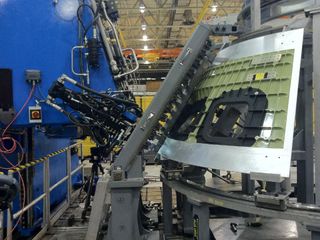NASA Starts Building 1st New Deep Space Capsule to Fly

NASA has kicked off construction of the first space-bound version of its next-generation deep space vehicle, a capsule designed to carry astronauts to an asteroid or Mars.
On Friday (Sept. 9), engineers at NASA's Michoud Assembly Facility in New Orleans completed the first welds on the spacecraft, which is called the Orion Multi-Purpose Crew Vehicle (MPCV). The capsule under construction will be the first space-tested version of the MPCV, officials said.
"This marks a major milestone in NASA's ambitious plans to send humans farther into space than the nation has ever been before," NASA spokesman David Weaver said in a statement. "We're not only working to send people into deep space, we are putting people to work right here in America."
The gumdrop-shaped MPCV is based on capsule designs originally drawn up for NASA's Orion spacecraft, which was part of the agency's now-defunct Constellation program to return astronauts to the moon by the 2020s.
President Barack Obama cancelled the Constellation program last year, directing NASA to work instead on sending humans to an asteroid by 2025, then on to Mars by the mid-2030s. [Photos: NASA's New Deep Space Capsule]
Lockheed Martin Corporation, NASA's prime contractor for Orion, is modifying the original capsule design to meet the new requirements of a vehicle capable of flying astronauts on long-duration missions to deep space destinations.

NASA and Lockheed officials have built several mock-ups and test versions of Orion for ground and splashdown tests, as well as for an emergency escape system test last year. But the new space capsule being built is the first one that will fly in space, NASA officials said.
Get the Space.com Newsletter
Breaking space news, the latest updates on rocket launches, skywatching events and more!
The first welds on the new Orion MPCV capsule were completed using a new friction stir welding process developed especially for MPCV construction, agency officials said. The new method creates a seamless bond stronger than any that can be achieved using conventional welding processes, they added.
MPCV testing has been ramping up lately. This summer, engineers at Lockheed Martin have been subjecting another prototype MPCV to a series of ground tests, checking out its strength and structural integrity.
The MPCV is designed to launch aboard a NASA heavy-lift rocket called the Space Launch System, which is still under development. But NASA officials have said they may use other rockets for MPCV test flights.
After the welding is finished at Michoud, the MPCV will be shipped to NASA's Kennedy Space Center in Florida. At Kennedy, the capsule's heat shield will be installed, and the vehicle will undergo final assembly and checkout operations for its first orbital test flight, officials said. They did not state when that flight would take place.
Follow SPACE.com for the latest in space science and exploration news on Twitter @Spacedotcom and on Facebook.
Join our Space Forums to keep talking space on the latest missions, night sky and more! And if you have a news tip, correction or comment, let us know at: community@space.com.

Space.com is the premier source of space exploration, innovation and astronomy news, chronicling (and celebrating) humanity's ongoing expansion across the final frontier. Originally founded in 1999, Space.com is, and always has been, the passion of writers and editors who are space fans and also trained journalists. Our current news team consists of Editor-in-Chief Tariq Malik; Editor Hanneke Weitering, Senior Space Writer Mike Wall; Senior Writer Meghan Bartels; Senior Writer Chelsea Gohd, Senior Writer Tereza Pultarova and Staff Writer Alexander Cox, focusing on e-commerce. Senior Producer Steve Spaleta oversees our space videos, with Diana Whitcroft as our Social Media Editor.
